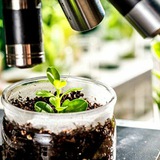Смотреть в Telegram
Augmentation of predatory mites for red spider mites control 🌱🕷️🕸️🍓
🕷️Predatory spider mite, Phytoseiulus persimilis, have specialized adaptations for attacking and feeding on their prey like the two-spotted spider mite. This can be regarded as most effective red spider mite predator when applied in optimum condition.
🪴They are being supplied in shaker bottles and should be sprinkled over the infested plants.
🕸️Phytoseiulus mites need to be released when red spider mites population are already existing because they cannot survive long when food is unavailable with temperature requirement at above 15C with 20-30C as the most ideal.
🌿When released, they employ an ambush strategy and can sense their prey by responding to chemical cues and vibrational signals.
📌They move quickly and use this speed to catch up with and capture prey.
📍Predatory mites have specialized mouthparts designed for piercing and sucking allowing them to feed on the body fluids of their prey.
♻️Different species of predatory mites may have preferences for specific stages of their prey's life cycle. Some may focus on consuming eggs, while others target nymphs or adult mites.
📈Predatory mites may adapt their foraging behavior based on the prevailing conditions. The availability and density of prey in the environment can stimulate predatory mites to feed more actively.
🌦️Temperature, humidity, and other environmental factors impact the activity and reproduction rates of both predatory and prey mites, influencing overall consumption rates.
🍓Predatory mites do not damage plants, but feed on plant pollen when prey is unavailable.
Video credit: https://lnkd.in/gGw7imQT
#linkedin #innovation #agriculture #ecology #development #technology #agribusiness
https://t.center/plantprotectionTAU
lnkd.in
LinkedIn
This link will take you to a page that’s not on LinkedIn
Telegram Center
Канал
